Tulips are among the most beloved spring-blooming flowers, celebrated for their vibrant colors and elegant shapes. Known to symbolize love and rebirth, tulips are a fantastic addition to any garden, adding beauty and charm with minimal effort. This comprehensive guide will cover everything you need to know about tulips, from planting and variety selection to care tips and maintenance strategies for thriving blooms each season. Our gardening blog is a perfect place to find all the information you need!
Understanding Tulip Varieties
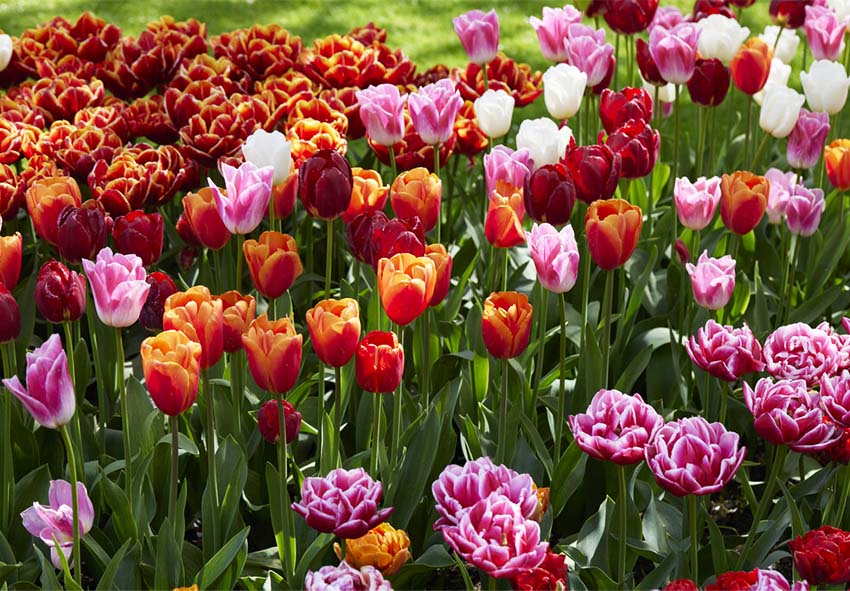
Tulips offer an incredible range of types and varieties that allow for endless garden design possibilities. Knowing the different types of tulips and popular cultivars will help you select blooms that suit your aesthetic and fit your garden’s needs.
Types of Tulips
Tulips come in various types, each with distinct characteristics in flower shape, size, color, and bloom time:
- Single Early Tulips: Blooming early in the spring, these tulips have a classic cup shape and are available in a range of colors.
- Double Late Tulips: Known for their layered petals resembling peonies, these tulips add fullness to garden beds and bloom late in the season.
- Darwin Hybrid Tulips: Popular for their large blooms and sturdy stems, Darwin hybrids are a reliable choice for vibrant, long-lasting color.
- Parrot Tulips: These exotic-looking tulips have ruffled petals and unique color combinations, adding texture and drama to any planting arrangement.
- Triumph Tulips: Known for their classic cup-shaped blooms, Triumph Tulips are available in a wide range of colors and bloom in mid to late spring.
- Kaufmanniana Tulips: Compact and early-blooming, Kaufmanniana Tulips feature star-shaped flowers that open wide in the sun, often with contrasting colors.
- Fosteriana Tulips: These tulips are admired for their large, elegant blooms and vibrant hues, making an impressive display in early to mid-spring.
Each type of tulip varies in height and bloom time, allowing gardeners to create a staggered display of blooms throughout the season.
Varieties of Tulips
Each variety of tulip has unique visual and growth traits, so selecting based on height, flowering period, and frost resistance can help create a harmonious and resilient tulip display in any garden:
| Variety | Botanical Name | Height | Color | Flowering Period | Frost Resistance |
| Single Early Tulip | Tulipa ‘Apricot Beauty’ | 30-45 cm | Soft apricot-pink | Early Spring | High |
| Double Late Tulip | Tulipa ‘Angelique’ | 35-50 cm | Pale pink, sometimes with hints of white | Mid to Late Spring | Moderate to High |
| Parrot Tulip | Tulipa ‘Black Parrot’ | 45-60 cm | Dark purple, almost black | Late Spring | Moderate |
| Kaufmanniana Tulip | Tulipa ‘Stresa’ | 20-25 cm | Red with yellow inner petals | Early Spring | High |
| Triumph Tulip | Tulipa ‘Queen of Night’ | 45-60 cm | Deep maroon-black | Mid to Late Spring | Moderate |
These popular varieties can be mixed for a colorful garden or grown individually to highlight specific colors or textures in your garden design.
Planting Tulips: Tips and Techniques
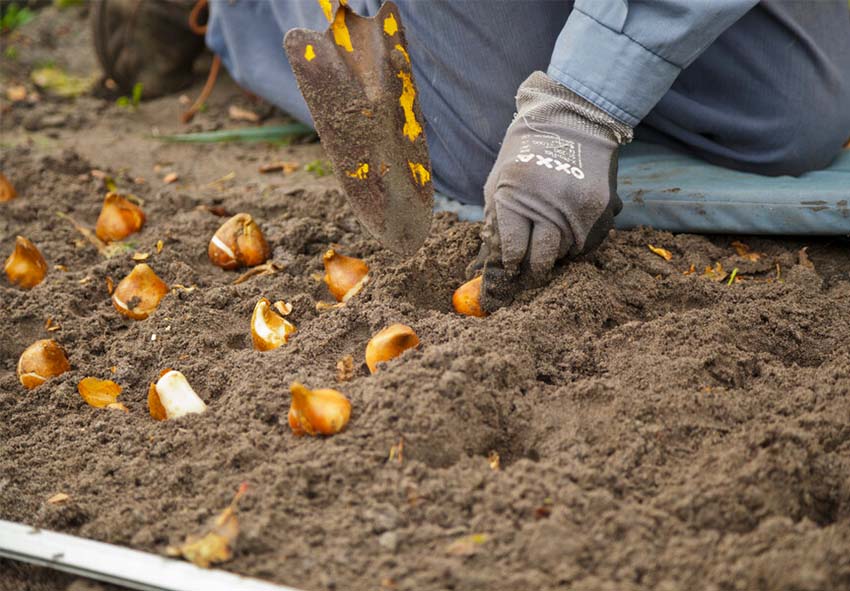
Planting tulips correctly is essential for ensuring healthy growth and robust blooms. From selecting the ideal location to preparing the soil, following a few key tips for planting tulips will help you enjoy a beautiful display of tulips in the spring.
Selecting the Right Location
Choosing the perfect spot for tulips is the first step in ensuring healthy blooms. Tulips thrive in areas with full sun, which encourages robust growth and vibrant flowers. It’s essential to plant them in well-draining soil, as waterlogged areas can lead to bulb rot. When planning your tulip display, consider the spacing between bulbs to prevent overcrowding and enhance visual appeal. Whether planting in garden beds or containers, proper spacing allows each plant to reach its full potential.
Soil Preparation
Preparing the soil is crucial for tulip growth, as they prefer fertile, well-drained soil with a slightly acidic to neutral pH (6.0-7.0). Loosen compacted soil and add organic matter such as compost to improve drainage and nutrient levels. Testing the soil pH can help determine if any adjustments are necessary; for example, lime can be added to raise the pH if the soil is too acidic. These steps create the ideal environment for tulip roots to establish and absorb nutrients effectively.
Planting Process
Planting tulip bulbs is a straightforward process, but paying attention to depth, spacing, and positioning ensures a healthy, vibrant spring display:
- Depth: Plant tulip bulbs at a depth of 6 to 8 inches, measuring from the bulb’s base. This depth provides insulation from the cold, protects the bulbs from potential frost damage, and encourages robust root development. In warmer climates, slightly deeper planting may be beneficial to help bulbs stay cool.
- Spacing: Space bulbs about 4 to 6 inches apart to give each bulb adequate room for air circulation and root growth. Proper spacing also reduces the chance of fungal diseases that can spread in overcrowded conditions. Grouping bulbs in clusters or rows works well for an impactful display, but be sure to maintain space between clusters as well.
- Positioning: Place each bulb with the pointed side (or “nose”) facing up, as this is where the stem will emerge. Cover the bulbs gently with soil, pressing it down lightly to eliminate air pockets that could expose bulbs to pests or drying out. For additional protection in colder climates, consider adding a light layer of mulch after planting to help retain moisture and stabilize soil temperature.
After planting, water thoroughly to encourage root establishment, but avoid overwatering, as soggy soil can cause bulbs to rot. Adding a layer of mulch can also help retain moisture and protect the bulbs from cold temperatures, especially in harsher climates.
Caring for Tulips for Optimal Growth
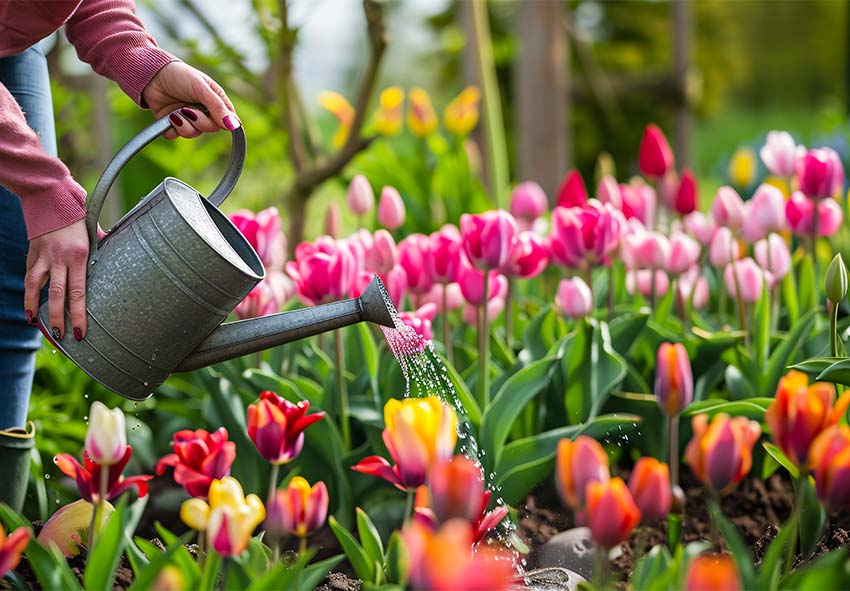
Tulips require ongoing care to ensure they bloom beautifully each year. Proper watering, fertilization, and deadheading practices contribute to vibrant tulips that thrive season after season.
Watering and Fertilizing Needs
Tulips require consistent moisture for optimal growth, but it’s crucial to avoid waterlogged soil, which can lead to bulb rot. Water them moderately, keeping the soil evenly moist but not soggy. During their active growth phase, especially in early spring, aim to water once a week, adjusting based on rainfall. In addition to regular watering, fertilize your tulips in early spring when they first emerge using a balanced, slow-release fertilizer. A 10-10-10 or similar formula works well to provide essential nutrients. Be cautious not to over-fertilize, as this can result in excessive foliage growth at the expense of blooms, diminishing the overall display.
After the flowering period, you can apply a low-nitrogen fertilizer to support bulb health without encouraging excess foliage. Ensure that the fertilizer is evenly distributed and water the bulbs after application to help the nutrients penetrate the soil. Monitoring soil moisture levels is crucial, especially in areas with fluctuating weather. If rainfall is insufficient, consider using a soaker hose to provide a consistent moisture level, which is particularly beneficial during dry spells.
Deadheading Spent Flowers
Deadheading tulips is a vital practice for enhancing their growth and performance in subsequent years. By removing faded flowers, you prevent seed formation, which would otherwise divert energy away from the bulb’s development. To deadhead effectively, snip the spent flowers at the base, ensuring not to damage the leaves. It’s important to leave the foliage intact, as the leaves continue to photosynthesize, storing energy in the bulb that’s essential for next year’s blooms. Wait until the leaves have completely yellowed and withered before cutting them back, as this allows the bulb to absorb maximum nutrients and energy for robust growth in the upcoming season.
In addition to deadheading, consider mulching around the tulip bed to maintain soil moisture and suppress weeds during the growing season. This mulch layer can help regulate soil temperature and improve overall soil health. When deadheading, also keep an eye out for any signs of disease or pests that could affect the foliage, as healthy leaves are crucial for energy production. By following these practices, you’ll ensure your tulips remain vibrant and healthy, providing beautiful blooms year after year.
Pest Control for Tulips
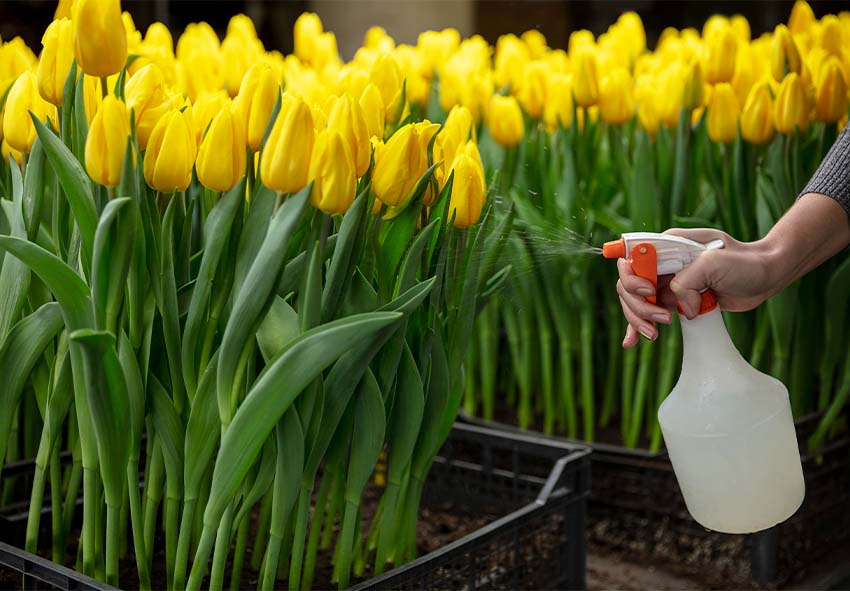
Tulips, though relatively low-maintenance, are susceptible to certain pests and diseases. Effective pest control is essential to ensure tulips reach their full blooming potential each spring. By identifying common pests and using appropriate management methods, gardeners can protect their tulips from damage and maintain the health of their garden beds.
Pest Management Strategies
Various pests, such as aphids, thrips, and bulb mites, can cause significant harm to tulips:
- Aphids: Aphids are tiny, soft-bodied insects that cluster on tulip stems and undersides of leaves, feeding on the plant’s sap. Their feeding weakens tulips, resulting in curled, yellowed, or discolored leaves.
Control methods: introducing natural predators like ladybugs, spraying with insecticidal soap, or using neem oil to deter aphids. Regularly inspecting tulips and washing off minor infestations can also keep aphid populations in check.
- Thrips: Thrips are tiny, slender insects that damage tulips by feeding on flower buds and leaves, leaving behind white or silver stippling and discoloration. This damage often causes deformed buds and leaves, reducing the beauty of the tulip blooms.
Control methods: regularly mist the plants to increase humidity or use a targeted insecticidal spray. For severe infestations, try introducing predatory insects like green lacewings or applying horticultural oils to protect your tulips from further damage.
- Bulb Mites: Bulb mites are tiny pests that attack tulip bulbs directly, feeding on the bulb’s outer layers (scales). Their feeding can cause bulbs to rot, leading to poor growth, reduced flowering, or even plant death. Infected bulbs may show brownish areas or soft spots, which can be a sign of mite presence.
Control methods: always start with clean, healthy bulbs, and avoid planting in soil where tulips have been affected by mites before. Consider treating bulbs with a mild insecticidal soak before planting and store them in cool, dry places away from other bulbs to prevent infestations.
Regular monitoring and implementing an Integrated Pest Management (IPM) approach, including rotating crops and maintaining garden cleanliness, can minimize pest damage and protect your tulips from harm.
Addressing Disease Issues

Tulips are also vulnerable to several diseases that can impact their health and longevity:
- Gray Mold: This fungal disease, also known as Botrytis blight, thrives in damp, humid conditions, especially when tulips are overcrowded or have poor air circulation. It often appears first as water-soaked spots on leaves and stems, which quickly turn brown or gray as the mold grows.
How to manage: improve air circulation by spacing tulips appropriately and avoid overhead watering. Remove any affected plant material promptly, and consider applying a fungicide if the disease persists.
- Tulip Fire: Tulip fire, also known as Botrytis tulipae, is a highly infectious fungal disease that causes brown or “burnt” spots on tulip leaves, stems, and petals. The disease spreads easily in wet conditions, as fungal spores can survive on soil and debris for long periods.
How to manage: remove any infected plants and surrounding soil immediately to prevent further spread. Plant tulips in well-drained soil, and avoid replanting in the same area for several years if tulip fire has been present. Fungicides can also help control this disease if applied early in the growing season.
- Viral Infections: Tulip viruses, such as the tulip breaking virus, cause streaking or mottling on flower petals and distorted growth, resulting in weakened plants with reduced vigor. These viruses are often spread by aphids, so maintaining pest control is essential to prevent infection.
How to manage:viral infections cannot be cured, so the best approach is prevention — inspect bulbs before planting, and immediately remove and dispose of any infected plants. Choose virus-resistant tulip cultivars if available, and practice crop rotation to reduce the risk of viral spread in your garden.
Enjoying Tulips Beyond Blooming
Tulip blooms can be extended and enjoyed well beyond their peak period. By selecting a range of tulip varieties and planning for post-bloom activities, gardeners can maximize the tulip season.
Extending the Blooming Season
You can prolong the tulip display by planting early, mid, and late-blooming varieties, creating a continuous wave of color throughout the season. Pairing tulips with other spring bulbs, such as daffodils and crocuses, can enhance your garden’s aesthetic appeal and ensure a steady bloom cycle. Companion planting with greenery or groundcovers can also provide a backdrop that highlights tulips as they blossom, enhancing garden design.
Harvesting Tulips
Harvesting tulips for indoor displays is a great way to enjoy their beauty. Cut the flowers when buds are just beginning to open for optimal vase life and longevity. Place harvested tulips in a clean vase with fresh water, and consider changing the water every few days to keep them looking vibrant. Properly harvested tulips can last up to a week or more indoors, adding a touch of springtime elegance to any room.
Designing with Tulips
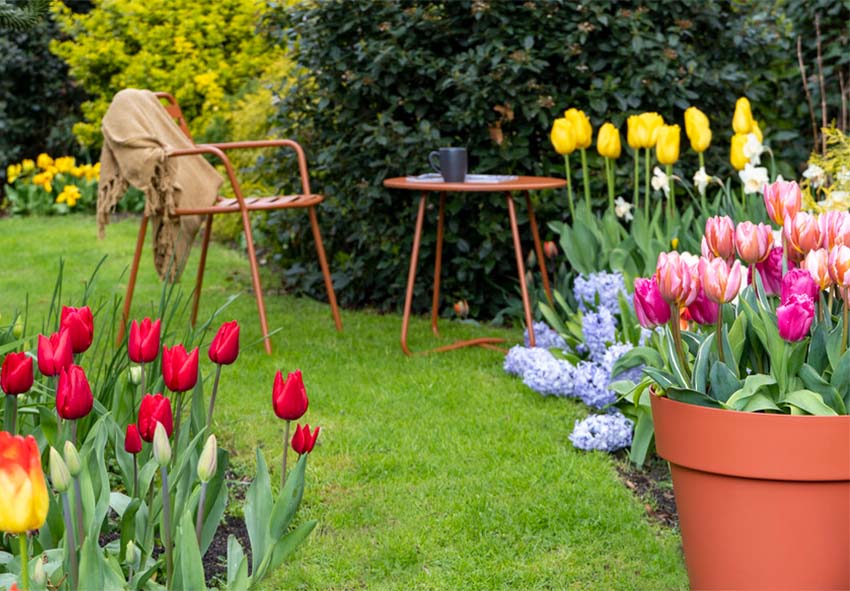
Tulips are not only perfect for outdoor gardens but can also enhance indoor spaces with their beauty and charm. Whether used as potted plants or in landscaping, tulips are a versatile option for both decor and garden design.
Using Tulips in Indoor Spaces
Incorporating tulips into home decor is a wonderful way to bring a springtime feel indoors. Place tulips in vases for a fresh, clean look that brightens any space. Pairing tulips with other houseplants or flowers like ferns or hydrangeas can create a balanced, harmonious look. For a minimalist feel, use a single color tulip, while a multicolor arrangement provides a bold, vibrant aesthetic.
Landscaping with Tulips
Tulips are a fantastic choice for enhancing outdoor garden beds, pathways, and borders, bringing vibrant colors and shapes to any landscape design. When creating a tulip-centric garden, it’s essential to consider the surrounding plants to create a cohesive and visually appealing display. Mixing tulips with complementary plants such as lavender, alliums, or ornamental grasses not only adds texture and contrast but also attracts pollinators and beneficial insects, enriching the garden ecosystem.
For a more dynamic look, combine tulips of varying heights and colors. Taller varieties, like the Darwin hybrids, can be positioned towards the back of beds, while shorter types, such as Triumph and Greigii tulips, are perfect for the front. This layering technique creates depth and visual interest, ensuring that each flower can be appreciated without overshadowing others.
Additionally, planning for seasonal companions is vital for maintaining garden interest throughout the year. After tulips bloom in spring, consider planting perennials like daylilies or peonies that will fill the space as tulips fade. Incorporating early-blooming bulbs, such as snowdrops or crocuses, can also enhance the garden’s appeal in early spring, providing color before tulips emerge.
When laying out your tulip design, think about incorporating curved or meandering pathways that lead visitors through the garden. This design approach allows for a more natural flow and offers different perspectives of the tulips from various angles. Edging pathways with low-growing plants or ground covers can help highlight the tulips and prevent grass encroachment.
Finally, consider the use of mulching materials to suppress weeds and retain soil moisture, ensuring that your tulips thrive throughout their growing season. By thoughtfully incorporating tulips into your landscape design, you can create a stunning garden that offers visual pleasure from spring through fall.
Conclusion
Selecting the right tulip bulbs based on size, quality, and variety is crucial for a successful tulip garden. To ensure a smooth growing season, prioritize timely bulb delivery and planting before the first frost sets in. With thoughtful planning, proper care, and effective pest and disease management, your tulips will bring a stunning array of colors and joy to your garden each spring.
Frequently Asked Questions (FAQs) about Tulips
1. When is the best time to plant tulip bulbs?
The ideal time to plant tulip bulbs is in the fall, approximately 6–8 weeks before the first hard frost. This timing allows the bulbs to establish roots before winter. In colder regions, plant tulips from late September to early October, while in warmer climates, you can plant as late as November.
2. Can I order tulip bulbs from your online store?
Yes, you can order tulip bulbs from our online store Dutch-bulbs.com. We offer a wide selection of tulip varieties suitable for different climates and preferences. Our bulbs are carefully sourced and stored to ensure they are of the highest quality. Shopping online provides you with convenience and access to valuable information about each tulip variety.
3. What types of soil do tulips prefer?
Tulips thrive in well-draining soil with a neutral to slightly acidic pH. Before planting, amend dense soil with organic matter like compost to improve drainage, as tulip bulbs can rot in overly moist soil. A well-prepared soil base promotes healthy root growth and enhances flowering.
4. How do I care for tulips after they bloom?
After tulip flowers fade, remove the spent blooms but allow the foliage to die back naturally. The leaves provide nutrients to the bulb for the next season. Once the leaves turn yellow, cut them back to ground level. Consider fertilizing after blooming to strengthen the bulbs for future growth.
5. What are some common pests and diseases that affect tulips?
Common tulip pests include aphids, thrips, and bulb mites, while diseases such as gray mold, tulip fire, and viral infections can also pose problems. Regular inspection and preventive care, like removing infected plants and using organic or chemical controls, can help maintain a healthy tulip garden.
Published: 30.10.2024
